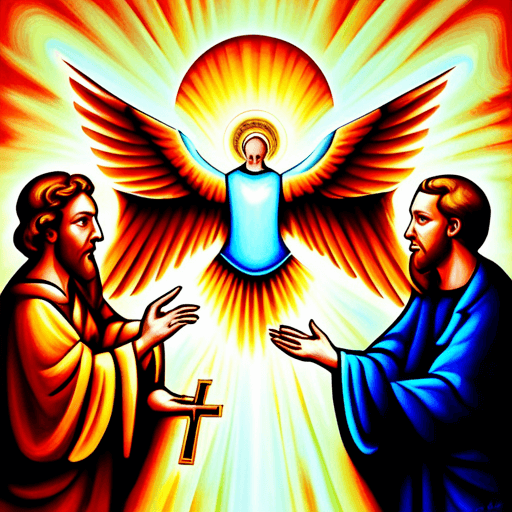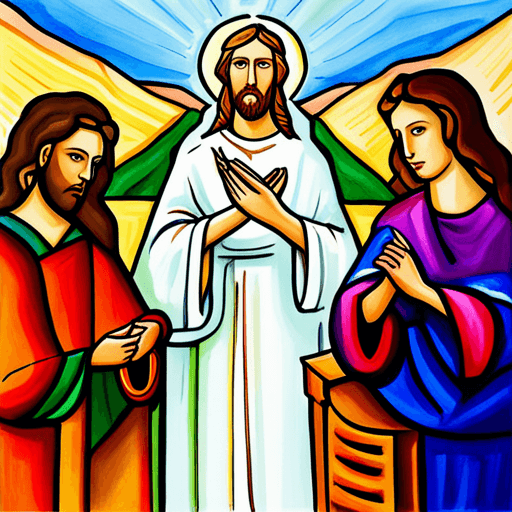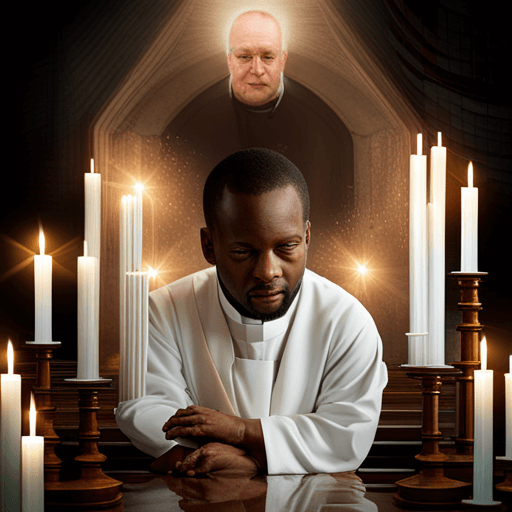Do you ever wonder about the meaning behind the ritual of the Eucharist in Catholicism?
The Miracle of the Eucharist, also known as Transubstantiation, is a central belief for Catholics worldwide. It is believed that during Mass, the bread and wine offered by the priest are transformed into the actual body and blood of Jesus Christ. This is not only a symbolic gesture but a literal transformation that holds great significance to believers.
Understanding Transubstantiation requires delving into its history and theological perspectives. From debates over its validity to personal reflections on its impact on individual faith, there is much to explore about this sacred practice.
Whether you are seeking to deepen your understanding or simply curious about this cornerstone of Catholicism, exploring The Miracle of the Eucharist offers valuable insights into this powerful sacrament.
The Significance of the Eucharist in Catholicism
You can’t talk about Catholicism without acknowledging the immense importance of this sacred ritual. The Eucharist, also known as Holy Communion or the Lord’s Supper, is believed to be the body and blood of Jesus Christ. This belief is central to Catholic doctrine and practice, making it one of the most significant sacraments in the Catholic faith.
Eucharistic Adoration and Communion Frequency are two important aspects associated with this sacrament. Eucharistic Adoration refers to the practice of worshipping the consecrated host outside Mass, while Communion Frequency relates to how often Catholics should receive Holy Communion.
Both practices allow for deeper connection with God through His presence in the Eucharist. As such, they are highly valued by devout Catholics who seek spiritual nourishment from this holy sacrament.
The History and Origins of Transubstantiation
Now you might be wondering where the idea of transubstantiation came from and how it evolved over time.
The origins of this doctrine can be traced back to the early Church Fathers, such as St. Augustine and St. Ambrose, who believed in the Real Presence of Christ in the Eucharist.
However, it wasn’t until the 12th century that theologians began using the term ‘transubstantiation’ to describe this belief.
The development of transubstantiation as a formal doctrine was influenced by various factors such as debates within the Church regarding Christ’s presence in the Eucharist, philosophical ideas about substance and accidents, and theological controversies surrounding heresy.
It wasn’t until the Fourth Lateran Council in 1215 that transubstantiation was officially recognized as a dogma of faith in Catholicism.
From then on, it became an essential part of Catholic worship and belief, signifying a profound mystery that connects believers with their God through participation in Holy Communion.
Theological Perspectives on the Miracle of the Eucharist
Theological viewpoints regarding the transformation of bread and wine during Mass have been a subject of intense debate throughout Christian history. The concept of transubstantiation, which holds that the bread and wine become the body and blood of Christ, has been embraced by Catholicism but rejected by other denominations.
Interfaith dialogue has also played a role in shaping contemporary interpretations of this miracle, with some Christians questioning whether it should be viewed as a literal or symbolic representation.
Despite these controversies, many theologians argue that transubstantiation is an essential part of Christian belief. They point to biblical passages in which Jesus speaks about his body and blood being given for the salvation of humanity. Additionally, they note that early Christian writers such as St. Augustine wrote extensively on the topic, offering insight into its theological significance.
Ultimately, while there may be varying perspectives on transubstantiation within Christianity and beyond, it remains a powerful symbol of faith for millions around the world.
Debates and Controversies Surrounding Transubstantiation
Get ready to dive into the debates and controversies surrounding what happens during Mass! One of the biggest theological disputes among Christians revolves around transubstantiation, or the transformation of bread and wine into the body and blood of Christ during Eucharistic celebration.
The Catholic Church teaches that the elements become the real presence of Jesus, while many Protestants believe in a symbolic representation. This disagreement has been ongoing for centuries and is still a point of contention today.
The debate over transubstantiation highlights deeper differences between Catholic and Protestant views on sacraments. For Catholics, sacraments are essential channels through which God’s grace flows to believers, with each rite conveying a different aspect of divine blessing.
For many Protestants, however, sacraments are more like memorials that commemorate Christ’s sacrifice but do not actually convey grace. As such, it is not surprising that they view communion as a symbol rather than an actual transformation.
Despite these differences, both sides acknowledge that communion is an important part of Christian worship and holds deep spiritual significance for believers everywhere.
Personal Reflections and Practices Related to the Eucharist
As a Catholic, you may understand the importance of the Eucharist in your faith. Receiving Communion during Mass is not just a ritualistic act, but a way to connect with God and feel his grace.
The idea of transubstantiation can be difficult to comprehend, but it’s believed that during the consecration of bread and wine, they become the body and blood of Christ.
Apart from receiving the Eucharist during Mass, many Catholics also have personal meditation practices related to this sacrament. This could include reflecting on the significance of Jesus’ sacrifice or pondering on one’s own spiritual journey.
Additionally, celebrating Communion as a community reinforces the idea that we’re all connected through our faith and shared experiences. As such, whether it’s partaking in Communion or engaging in private reflection, the Eucharist remains an integral part of Catholic life for many believers.
Frequently Asked Questions
Are there any denominations other than Catholicism that believe in transubstantiation?
If you’re curious about interpretations of the Eucharist beyond Catholicism, there are indeed Protestantism alternatives that believe in some form of transubstantiation.
Anglicans, for example, hold to a doctrine called ‘real presence,’ which asserts that Christ is truly present in the elements of bread and wine during Communion.
Lutherans also affirm this belief, though they describe it using different language than Catholics do.
While not all Protestants accept the idea of transubstantiation or real presence, it’s clear that there are diverse understandings of the sacrament across Christian traditions.
Whether you align with one view or another, exploring these differences can deepen your understanding of faith and help you feel more connected to your community’s beliefs.
Is there any scientific evidence that supports the miracle of transubstantiation?
You may be wondering if there’s any scientific evidence that supports the transubstantiation miracle. This is the belief that during Mass, the bread and wine become the actual body and blood of Jesus Christ. While there are no empirical studies to prove this phenomenon, some Catholic philosophers argue that science cannot fully explain the spiritual realm.
They point out that faith isn’t solely based on tangible evidence, but also on personal experiences and beliefs passed down through tradition. Ultimately, whether or not one believes in transubstantiation relies on a combination of religious teachings and individual interpretation.
How do Catholics reconcile the idea of consuming the body and blood of Christ with the concept of cannibalism?
As a Catholic, you may wonder how the act of consuming the body and blood of Christ can be reconciled with the concept of cannibalism. However, from a Catholic perspective, this act is not seen as cannibalism because it is believed that the bread and wine are transformed into the actual body and blood of Christ through transubstantiation.
This transformation is not symbolic representation but rather a true miracle that occurs during Mass. Therefore, when Catholics partake in communion, they are not consuming ordinary bread and wine but rather receiving Christ himself.
While this concept may seem difficult to grasp intellectually, it provides a profound sense of belonging for those who believe in it.
Can non-Catholics participate in the Eucharist?
If you’re a non-Catholic, it’s important to understand the theological justifications and interfaith implications of participating in the Eucharist.
The Catholic Church teaches that the Eucharist is not just a symbol, but actually becomes the body and blood of Christ through transubstantiation. Therefore, when Catholics participate in the Eucharist, they are receiving Jesus himself.
Non-Catholics who don’t believe in transubstantiation may feel uncomfortable participating in this sacrament. Additionally, some Catholics may view participation by non-Catholics as disrespectful or inappropriate.
Ultimately, it’s up to each individual to determine if they feel called to participate in the Eucharist within a Catholic context. However, it’s important to approach this decision with respect for Catholic beliefs and practices.
How has the practice of the Eucharist evolved over time?
As you explore the Evolution of Practice and Historical Context of the Eucharist, you’ll find that this sacred ritual has transformed over time.
From its early origins in the first century to modern-day practices, the Eucharist has been shaped by various cultural, social, and religious influences.
The use of bread and wine as symbols of Christ’s body and blood has remained constant throughout history, but other aspects such as language used during the ceremony, frequency of participation, and even who’s allowed to partake have all undergone changes.
Understanding how these transformations occurred can provide a deeper appreciation for the significance and meaning behind this sacrament.
Conclusion
Congratulations! You’ve now gained a deeper understanding of the miracle of the Eucharist and its significance in Catholicism.
Through exploring the history and origins of transubstantiation, as well as various theological perspectives on this miraculous event, you’ve gained insight into the debates and controversies surrounding it.
As you reflect on your own personal experiences with the Eucharist, you may find yourself drawn to different aspects of this sacred ritual. Whether it’s through prayer, meditation, or simply taking time to appreciate the beauty and mystery of transubstantiation, there are many ways to deepen your connection with this powerful symbol of faith.
Ultimately, whether you view the Eucharist as a literal transformation or a symbolic representation of Christ’s sacrifice, one thing remains clear: it holds a special place in the hearts and minds of Catholics around the world.
By continuing to explore its meaning and significance, you can gain a greater appreciation for this timeless tradition and all that it represents.




